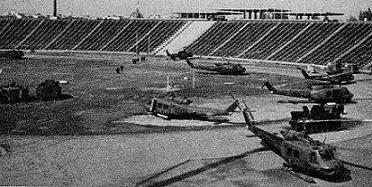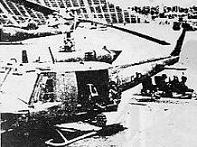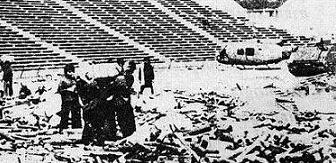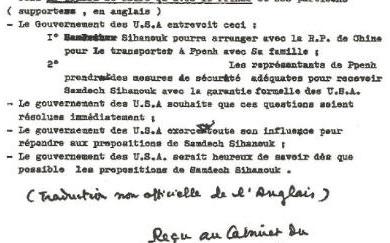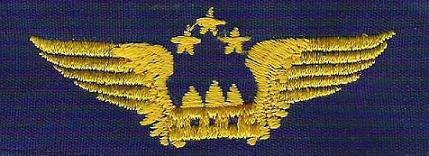 |
| Notes Anecdotes The End (en) |
|
Phnom-Penh, les derniers jours
Avril 1975 La pression est forte mais les Khmers Rouges n’ont pas lancé d’offensives sur Phnom-Penh. En plus des militaires, des dizaines de milliers d'habitants sont armés. Avec les réfugiés, des millions de personnes, certes exténuées, ont trouvé asile derrière les lignes républicaines. Rien que dans la Capitale, ils étaient plus de deux millions. En même temps, les politiques ne pensent plus qu'à pourparler avec le Prince Sihanouk et son Front Unit avec les Khmers Rouges. La motivation des troupes n'est plus au combat alors que les communistes continuent eux, à tirer des roquettes au hasard sur la population pour saper le moral. Au milieu de ce climat d'incertitude totale, le pilote Khiev Yoursawath bombarda le Quartier Général des Armées. Pochentong Les pilotes de FAC ont indiqué que les soldats gouvernementaux abandonnent leurs postes sur la ceinture de défense de Phnom-Penh. Armes sur l'épaule, ils rentrent vers la ville. Ce jour là, tout le monde fut consigné à la base mais aucune directive ne fut donnée. Après les tirs de roquettes, Pochentong est maintenant à portée de mortiers. Dans les habitations, soldats, pilotes et leurs familles sont tués ou blessés tel le Lt Men Kunthea ou encore le Lt Ros Saourn, tué par un obus de mortier qui toucha son T-28 lors d'un atterrissage. Il fut un moment question d’aller rejoindre un camp préparé par les américains à UTapao. Des plans de vol sont établis. Les pilotes devaient prendre une tenue civile en plus de la combinaison de vol mais aucun ordre n'arriva. Avec le pilonnage, la plupart des avions de Pochentong ont été dispersés. Ne restèrent que des T-28. Durant les dernières semaines, les missions d'appui-sol s'effectuaient à partir des autres bases qui ont dû monter en capacité opérationnelle. Un autre terrain complémentaire plus proche de Phnom-Penh fut aménagé à partir d’une route. Le nombre de refugiés grossit rapidement à Psar-Pochentong, localité proche de la base. Subitement, parmi eux, des groupes de KR en civils ont sorti des armes et se sont mis à tirer sur tous les véhicules de passage. Technique classique des Communistes qui utilisent la population civile comme bouclier. D'un autre coté, les derniers réfugiés n'ont pas été fouillés car il n’y avait quasiment plus de postes de contrôles autour de la capitale. Le 15 Avril, les KR coupent la route de Pochentong. Pour Phnom-Penh, la base est perdue; mais jusqu'au dernier jour, les Communistes ne réussirent pas à venir à bout du système de défense de celle-ci. Tout en continuant les pilonnages d’artillerie, ils ont préféré poursuivre leur route vers Phnom-Penh. La base avait vainement demandé de faire héliporter des conducteurs pour les quelques auto blindés légères récemment reçues à Pochentong. En effet, ne pouvant utiliser les armes lourdes ou faire intervenir des avions à cause de la présence de la population, les fusiliers de l’Air voulaient tenter une sortie pour déloger les KR à Psar-Pochentong. Il leur manquait des véhicules de combat pour s’y rendre. Dans la journée du 17 Avril, progressivement, les personnels de la base s'éclipsèrent en habits civils. Il n'y avait plus d'encerclement et les premiers KR pénétrèrent dans la base. Au même moment, quelques T-28 parviennent à décoller. A la demande des derniers défenseurs, principalement des groupes de fusiliers qui ne voulaient pas déposer les armes, ces avions bombardèrent leur propre base avant de s’éloigner. État-major, Phnom-Penh
Kompong Chnang La situation fut des plus troubles. Beaucoup d'appareils s’y trouvaient. Ils venaient notamment de Pochentong et de Kampong Cham. Des discussions rapides ici et là entre navigants, il fut décidé de partir vers le nord car des bruits courent que de là-bas, s'effectuerait la résistance. Avec la plupart des familles laissées sur place, ils espéraient résister et trouver un moyen pour revenir. Dans toute cette précipitation, il n’y avait pas eu de concertations avec les autres corps comme les fusiliers de l’Air ou les mécaniciens. Certains pilotes comme Ok Sam Ath qui laissa partir sa femme et ses enfants, choisit de rester défendre la base avec les unités au sol. Malgré cela, au fur et à mesure des décollages, certains parmi ces derniers, finissent par mettre des obstacles sur la piste. De l’avis même des pilotes qui partirent ainsi de Kampong Chnang, ils étaient considérés comme des fuyards abandonnant leurs postes. Des hélicoptères venant de Phnom-Penh et transportant des membres du Gouvernement se posèrent pour être ravitaillés; ils furent carrément retenus. Le Col Neang Lee, commandant de la Base de Battambang, a dû venir sur place pour gérer la situation. Il avait auparavant dirigé la base de Kampong Chnang. Il réussit à convaincre les hommes de laisser partir les hélicoptères vers Oudor Meanchey afin de constituer un centre de résistance. Cette idée de dernière minute fut suggérée par quelques membres du dernier Gouvernement mais ce fut un plan improvisé et sans préparations sérieuses. En tous cas, la base fit confiance à Neang Lee et les hélicoptères ont pu repartir. Battambang La base hébergeait l'Ecole de l'Air mais elle avait aussi des unités opérationnelles qui assuraient des appuis aux troupes de la région. Les T-28 effectuèrent les missions jusqu’au bout, le 17 Avril. La veille, les AC-47 Gunships sortaient comme normalement. Il y a eu peu de tirs d’artillerie sur la ville de Battambang et la base aérienne demeurait intacte. Le 17 Avril 1975, le commandant de la base, le Col Neang Lee partit résoudre une situation des plus graves à la base de Kampong Chnang. Ce dernier jour, le commandement tactique était confié au Commandant de l'Ecole de l'Air, le Col Lim Kimkhun. Il a donné l'ordre d'évacuer la base à 13.30h. A Battambang aussi, les personnels au sol étaient extrêmement déçus et en colère contre la reddition du gouvernement annoncée à la radio dans la matinée mais contrairement à Kampong Chnang, il n'y avait pas eu d’actions à l’encontre des navigants qui s'envolèrent. Cependant, le dernier groupe d'avions qui devait décoller, se résuma en un seul C-47 avec plusieurs pilotes comme passagers! Alors qu'ils devaient ramener des T-28 supplémentaires, ces pilotes ont constaté que les câbles de batterie ont été coupées! Il n'était plus question de rester pour mener des enquêtes. Kampong Cham Dans le passé et à plusieurs reprises, le Commandant de la base, le Col Meas Maroth avait réussi avec les Fusiliers de l'Air, à repousser les Communistes. Cette fois-ci encore, il ne compta pas baisser les bras. Son adjoint, Ma Kim Oeun, était tout aussi déterminé. Abattu par deux fois, en missions aériennes, il avait annoncé six mois auparavant, que de toutes les façons, les Communistes l'attendraient personnellement de pied ferme. Un membre de sa famille était en fait un chef KR local et lui en voulait. La base de Kampong Cham, isolée, décida de suivre une nouvelle et dernière fois ses chefs! Les hommes résistèrent jusqu'à ce qu'ils soient à cours de munitions, plusieurs jours (peut-être même une semaine) après le 17 Avril. D’après les informations communiquées par les Américains au Bureau Militaire de la République Khmère à Washington, les combats étaient trop rapprochés pour larguer du ravitaillement aux assiégés. En effet, sous couverture de sociétés civiles, des avions américains sous contrat avec la CIA continuèrent à parachuter des ravitaillements sur le Cambodge jusqu’à la reddition du Gouvernement. Les survivants de la base furent tous exécutés. Kampong Som (Ream) Etabli depuis 1971, le plan d’évacuation de l’AAK prévoyait de faire de Ream une base de repli pour Pochentong. Pour défendre son accès, deux collines clefs devaient être contrôlés. Pour le reste, Ream était dos à la mer. Ce plan fut aussi déposé à l'État-major Général des Armées. Il prévoyait aussi l’évacuation de quelques membres du Gouvernement. Des stocks prévus pour tenir plusieurs mois avaient été constitués mais il est maintenant trop tard pour amorcer quoique ce soit. Ces vivres et munitions n'ont finalement pas servi à grand choses. Les Américains bombarderont plus tard la base lors de l’incident du Mayaguez. Il y eut un grand incendie dû à l’énorme quantité de carburant entreposée. Durant les dernières semaines, certains militaires ont évacué beaucoup de membres de leurs familles vers cette base. Certains étaient au courant des réserves en dépôts et en dernier recours, ils pouvaient aussi embarquer sur les bateaux. Les KR étaient loin d’avoir les capacités de poursuite en mer. La base ne subit aucune attaque. Les pilotes de Ream ont aussi attendu le dernier jour avant de quitter le Cambodge. * * * * * * * * * * * * * * * *
* * * * * * * *
>> Le 17 Avril à 1h du matin, nous décollions du stade Olympique pour Kampong Cham. De là, nous partîmes à Siemreap à bord d'un Gunship AC-47 piloté par le Cdt Kong Lach et Tes Chanthan. Après avoir transité par Udor Meanchey, nous atteignions Utapao le jour suivant. (Bunna) >> Ngy Kheam (Promotion 10) était pilote de T-28 à la base de Ream. Le 17 Avril 1975, il était sur le siège arrière de mon T-28. Nous devions nous rendre à UTapao. Le moteur était déjà en route quand il sauta de l’avion. Il me dit qu’il ne veut finalement plus quitter le pays. J’ai l’ai laissé et j’ai décollé. (Mony) >> Kampong Chnang, 17 Avril matin. Quand nous avions entendu la voix des KR à la radio nationale, nous décidâmes d’aller à Siemreap, puis Odor Meanchey. Là, le soir même, nous assistions à une réunion tenue par le Commandant en Chef des Armées, Sak Sutsakhan, qui envisageait la formation d’un bastion de résistance. Plus tard durant la nuit, nous apprîmes que tout le plan s’était écroulé et qu’il n’y avait plus rien! Nous n’en connaissions pas les raisons. Trois autres hélicoptères et moi-même, mettions alors le cap vers le Phnom Dangrek, puis Surin, en Thaïlande. (Chantha) >> Pour rejoindre le nord du Cambodge, la zone de résistance, il était prévu que je prenne la place arrière du T-28 du Col Tan Sam-Hong. "Malheureusement", mon casque a disparu. Par mesure de sécurité, le Colonel n'a pas voulu que je monte et m'envoya sur le C-123 qui part avant. Son T-28 se crasha peu après le décollage! Son ailier fit demi-tour et atterrit... (Doeun) D'autres suivront les mêmes chemins de l’exil de ces pilotes qui décollèrent au dernier moment, mais à pied! En sortant de l’État-major, Sully mettra ainsi plus d'un an pour atteindre la Thaïlande en marchant de nuit … Des départs précipités sur les différentes bases, dont pour certains, quelques jours après même la chute de Phnom-Penh, Il y eut malheureusement plusieurs crashs. Certains ont été victimes des tirs ennemis, mais aussi des pannes mécaniques. Beaucoup ont décollé sans avoir eu le temps de vérifier l’appareil. Le Lt Kim Heng, son équipage et toute sa famille s'écrasèrent ainsi en mer. D’autres, miraculeusement, atteignirent la Thaïlande comme le Lt Riem Chean qui a pris un hélicoptère UH-1H, un jour après la chute du pays. Il a décollé de nuit alors que 25 personnes s’y entassaient à bord. Il n’a fait le décompte qu’après avoir atterri! En raison du poid, l'atterrissage était si brutal que le train d'atterrissage se cassa et le pare-brise fut brisé. Après la chute de Phnom-Penh, l'Adjudant-chef Meas Sambat de l'État-major a pu se rendre à Pochentong en se mélangeant à la population. Il voulait retrouver son cousin So Savath, fusilier de l'Air, qui était hospitalisé à la base aérienne. Il vit beaucoup de morts. A l’hôpital de la base, il retrouva son cousin et les autres patients; tous tués. Eventrés à l’arme blanche. * * * * * *
* * * * * * * * * * * * * * * * * *
Quand Phnom-Penh tomba, les trois quarts des appareils de l'AAK étaient encore opérationnels. De ses cinq bases, trois demeuraient intactes. Deux autres étaient encerclées mais étaient encore en mesure de porter des coups à l'ennemie si elles étaient appuyées. Les communistes n'avaient pas assez d'effectifs pour lancer des offensives en même temps partout dans le pays. Les Américains avaient hâte que le conflit se termine. Dans cette optique, même le Prince Sihanouk est devenu un leader dont les États-Unis s’empressèrent de rendre acceptable et contraignirent le Maréchal Lon Nol à quitter le pouvoir et le pays. Toutefois et en parallèle, l’USAF continua à larguer des ravitaillements sur les enclaves assiégées. Des avions C-130 et des anciens pilotes militaires sont transférés dans des «compagnies écrans» civiles. Ces avions continuèrent à soutenir les villes Khmères jusqu'à la reddition officielle du gouvernement le 17 Avril 1975. Ils auraient continué s’il y avait eu un gouvernement avec la volonté de résister car les crédits alloués n’étaient pas encore épuisés. A Washington DC, des anciens militaires américains et des particuliers avaient contacté l'ambassade et surtout le Bureau Militaire de la République Khmère. Ils voulaient apporter quelques aides. Par exemple, ils disposaient de vedettes pour alimenter d'éventuels points de résistances sur les cotes cambodgiennes. Certains étaient volontaires pour se rendre sur place. Matériellement, c'est peu de chose, mais ils voulaient surtout procurer un soutien psychologique et mettre le Sénat devant le fait accompli : un gouvernement cambodgien certes affaibli, mais anticommuniste et engagé au coté des Etats-Unis depuis le début, continue la résistance. Poussé par les Etats-Unis, le gouvernement cambodgien se focalisait sur un plan de paix avec le Prince Sihanouk. Il était le président d'un front uni avec les KR qui n’avaient eux, aucune raison de négocier quoique ce soit. Ils étaient en position de force. Un autre courant essayait de se tourner tardivement vers les Communistes prosoviétiques. Dans tous les cas, aucun plan de repli militaire ne fut pris en considération sauf lorsque les Communistes et le Prince annoncèrent officiellement qu’ils rejetaient tout plan de paix. Le gouvernement n’avait alors plus le temps pour réfléchir. Les Communistes sont déjà aux portes de Phnom-Penh. Ils défilent vers le centre sans rencontrer aucune opposition. Malgré la pénurie et l'inflation qui ont rendu la vie quotidienne très difficile, le dernier Cdt de l'AAK, Ea Chhong, parvint à maintenir à un haut degré le niveau des sorties de nos appareils et le personnel parvint à conserver un haut niveau de combativité (1) Cependant, la politique a pris le dessus. Dans le dernier gouvernement, les Commandants en Chef de la Marine et de l’AAK étaient aussi appelés pour faire partie d'un Conseil Suprême censé être un gouvernement de transition. Des changements de postes précipités eurent lieux, y compris dans l'AAK. Dans cette période critique, l’organisation fut rapidement perturbée et la chaîne de commandement disloquée. Il n'y eut aucune directive militaire claire alors que dans les échelons subalternes, jusqu’au bout, les pilotes et les soldats de l’AAK demeuraient à leurs postes. Certains éléments isolés, tel le pilote qui bombarda Phnom-Penh le 14 Avril, ne doivent pas jeter le discrédit et ternir l’image des dix milles autres aviateurs qui ont servi loyalement leurs pays. Notamment les Fusiliers de l’Air qui se sont sacrifiés, continuant à combattre pour défendre leurs bases alors qu’il n’y avait plus d’avions en opérations. Témoignages des sous-officiers et officiers des BA de Pochentong, Kampong Chnang, Battambang, Kamponk Saom, de l'Etat-Major à Phnom-Penh, du Bureau Militaire de Washington DC et de la base US d'Udorn. Certains ont transité par l'aéroport de Siem Reap, des terrains comme Odor Meanchey ou encore le stade Olympique de Phnom-Penh : Chhay Mony, Christoper Sim, Hao Sok Chantha, Keo Vong Sully, Meach Bunna (David B. Em), Kong Chhay Hong, Meas Sambat, Medh Patrick Keo, Om Vannac, Riem Chean, So Satto, Su Chhom Doeurn, Su Sampong, Yorn Im .... |
| Notes Anecdotes La Fin (fr) |
The End
|
La fin de Phnom-Penh et l’arrivée des "hommes en
noirs"
The end of Phnom-Penh. In and around the stadium;
the arrival of the "men in black"
(Photos N&B;
archives de Darasy Var) |
|||
|
Phnom-Penh, the last days
*
* * * * * * * * * * * * * * * * * * * * * * *
*
* * * * * * * * * * * * * * * * * * * * * * *
Testimonies of NCOs and officers from Pochentong AB, Kampong-Chnang AB, Battambang AB, Kampong Saom AB, the Headquarters at Phnom-Penh, the Military Bureau at Washington DC and the Air detachment at the US AB at Udorn, Thailand. Some transited via Siem Reap airport, Odor Meanchey airfield and the Olympic stadium at Phnom-Penh : Chhay Mony, Christoper Sim, Hao Sok Chantha, Keo Vong Sully, Kong Chhay Hong, Meach Bunna (David B. Em), Meas Sambat, Medh Patrick Keo , Om Vannac, Riem Chean, So Satto, Su Chhom Doeurn, Su Sampong, Yorn Im .... |
Ref:
The week before Phnom-Penh fell, the White House sent a message to Prince Sihanouk : See below document in French. In summary, the US will provide him a full support as the new head of a new Cambodian government.
Long before this message, there were of course several meetings between the US and China regarding Prince Sihanouk as a new head of the Cambodian state : Washington, Feb 8, 1975; Beijing, November 27, 1974; ... La semaine avant la chute de Phnom-Penh, la Maison Blanche envoya un message au Prince Sihanouk : Voir le document ci-dessus ou le télécharger ci-dessous Bien avant, il y eu des discussions entre les Etats-Unis et la Chine relatives à la mise en place du Prince Sihanouk à la tête d'un nouveau gouvernement : Washington, 8 Fev 1975;Beijing, November 27, 1974; ... |
